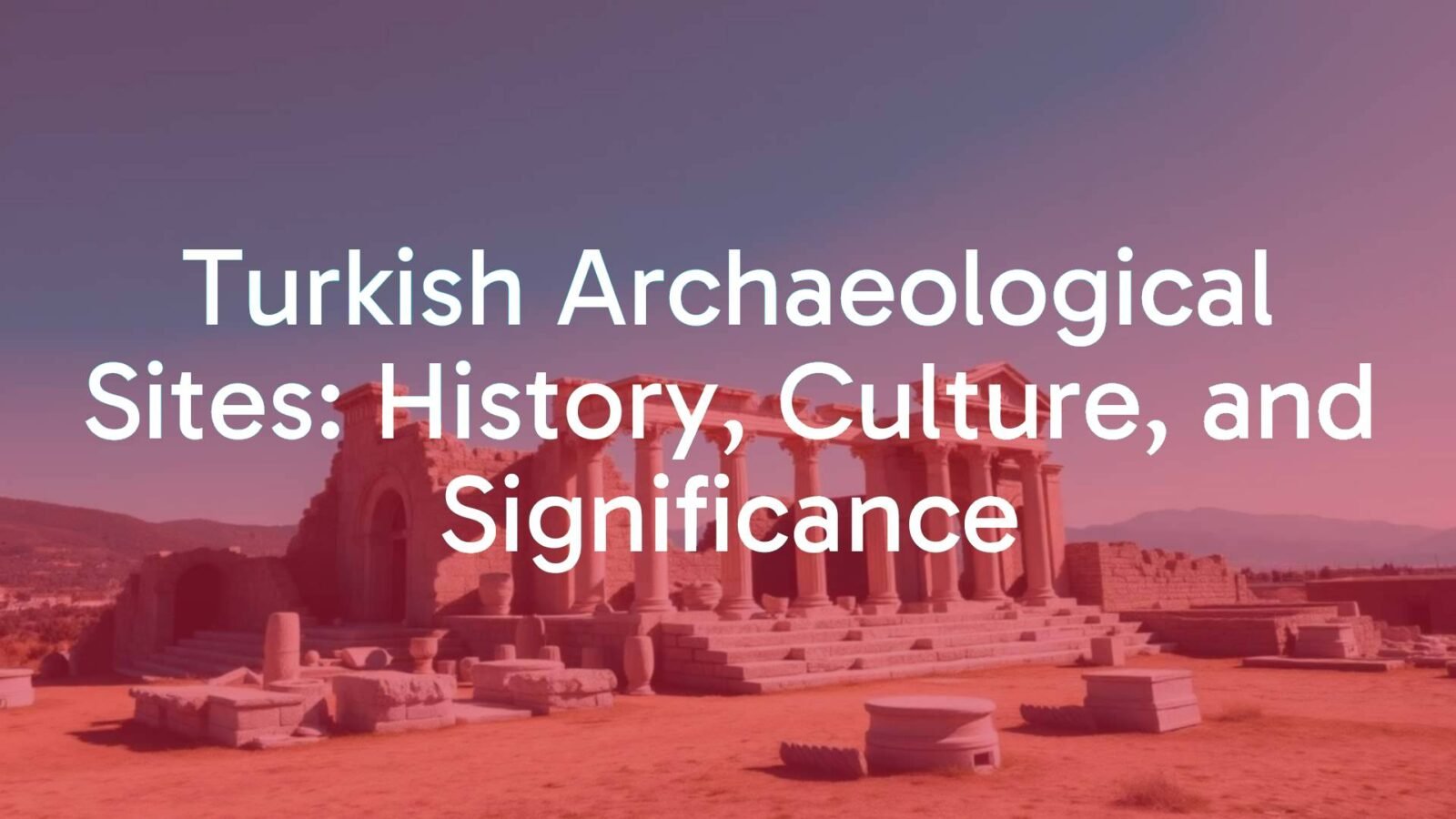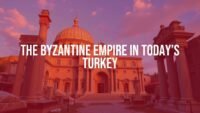Turkey is often called the “largest open-air museum on Earth.” The country is full of ancient remains, offering a clear look into different time periods and the many civilizations that once lived on this land between Asia and Europe. Turkey’s archaeological sites are more than scattered old stones-they are real links to the past. This guide will explain what makes Turkish archaeological sites special, which cultures built them, and why they still matter today.
What Are Turkish Archaeological Sites?
Turkish archaeological sites include a wide range of historic and prehistoric remains, with evidence stretched across thousands of years. These places show the journey from the first villages to the advanced cities of great empires. Evidence at these sites can be anything from tools, graves, buildings, and roads up to entire ancient cities.
What is an Archaeological Site in Turkey?
In Turkey, an archaeological site is any location with traces of past human life. This could be as simple as a small group of old tools or as complex as a huge city with temples, homes, and theaters. Turkey’s position at the crossroads of continents means many cultures have lived here, so you often see several layers from different time periods stacked on top of each other at one site. Archaeologists study both the physical remains and the stories they tell about daily life, religion, inventions, and social order. Their research helps us understand how people lived, worked, and believed long ago.
How Ancient Are Turkey’s Oldest Sites?
Some of Turkey’s oldest sites, like Göbekli Tepe, go back almost 12,000 years (to around 10,000 BCE), making it one of the oldest known religious sites on the planet. This discovery changed how we think about early human society because it showed that complex buildings and social structures might have existed before farming. Another site, Çatalhöyük, is about 9,500 years old and gives us unique examples of ancient city life. These and similar sites help us see how people went from being hunters and gatherers to farmers living in villages-a massive change known as the Neolithic Revolution.

Who Built Turkey’s Ancient Sites?
Turkey’s archaeological sites were created by many groups over thousands of years. Early hunter-gatherers first left their mark, followed by powerful groups like the Hittites, who built the city of Hattusa. Other notable cultures include the Phrygians (known for King Midas), Greek city-states like Ephesus and Pergamon, Romans, and later the Byzantines, Seljuks, and Ottomans. Each group added its own style and structures, making Turkish archaeology very rich and varied.
How Geography and Environment Affect Archaeological Sites
Turkey’s diverse land-with mountains, plains, rivers, and seas-has strongly influenced where ancient peoples built their settlements and how their remains survived. Geography shapes not only the location but also the preservation of many sites.
Key Archaeological Regions
- Aegean and Mediterranean coast: Known for Greek and Roman cities (like Ephesus and Pergamon).
- Central Anatolia: Early farming sites and the heartland of the Hittite Empire (Hattusa).
- Eastern/Southeastern Anatolia: Earliest known settlements (like Göbekli Tepe and Çatalhöyük).
- Black Sea coast: Fewer big cities but important for unique local culture and history.
These areas differ in resources and landscape, so the types of settlements, building materials, and city layouts also vary.
How Climate and Land Shape Sites
Water sources like rivers and springs were the main reason ancient people settled in certain places. Good examples are the irrigation systems found at Göbekli Tepe and the fertile lands around Ephesus. Natural features like hills and mountains offered defense, leading to fortified cities like Hattusa. Earthquakes sometimes destroyed buildings, but also buried and protected ancient remains, as seen at Nemrut Dağı. Soil and climate also affect preservation, with some dry areas helping to keep delicate things like wood and grain safe for thousands of years.

Major Historical Periods of Turkish Archaeology
Turkey’s archaeological history is very long and includes many phases. Each period has left behind distinct ruins and artifacts, building a timeline of change.
| Period | Main Features | Examples |
|---|---|---|
| Neolithic/Prehistoric | First villages & temples, farming begins | Göbekli Tepe, Çatalhöyük |
| Bronze Age | Rise of Hittite Empire, early cities | Hattusa, Alacahöyük |
| Greek/Roman | City-states, grand buildings, philosophy | Ephesus, Pergamon, Aphrodisias |
| Byzantine | Spread of Christianity, fortresses, churches | Göreme, Myra, Basilica Cistern |
| Seljuk/Ottoman | Mosques, trade inns (caravanserai), baths | Istanbul, Bursa, caravanserais like Ağzıkarahan |
Highlights from Each Period
- Neolithic: Göbekli Tepe shows early temples, while Çatalhöyük reveals new urban living.
- Bronze Age: Hattusa was the Hittite capital, known for its walls and written archives.
- Greek/Roman: Ephesus and Pergamon are famous for their theaters and temples. Roman baths and roads still remain in places like Hierapolis.
- Byzantine: The Göreme churches and Istanbul’s cisterns are key sites from this era.
- Seljuk/Ottoman: Inns, mosques, and large public buildings form much of more recent Turkish archaeology.
Most Famous Archaeological Sites in Turkey
Turkey is filled with important archaeological locations. Here is a summary of the most well-known ones:
| Site | Location | Main Features |
|---|---|---|
| Göbekli Tepe | Şanlıurfa | World’s oldest temple complex, large carved pillars |
| Çatalhöyük | Konya | Early “city,” dense houses, ancient wall paintings |
| Troy | Çanakkale | Legendary city from the Iliad, many occupation layers |
| Ephesus | İzmir | Large Roman theater, Library of Celsus, Temple of Artemis |
| Pergamon | Bergama | Hilltop acropolis, theater, former large library |
| Hattusa | Boğazkale | Hittite city walls, gates, cuneiform archives |
| Nemrut Dağı | Adıyaman | Mountain sanctuary, giant stone head statues |
| Aphrodisias | Aydın | Roman city, stadium, famous for marble sculptures |
| Hierapolis & Pamukkale | Denizli | Hot springs, Roman baths, theater, white travertine terraces |
| Derinkuyu | Cappadocia | Multi-level underground city used as refuges |
| Lycian Tombs (Myra) | Demre | Rock-cut tombs, theater, linked with Saint Nicholas |

Common Features Across Turkish Archaeological Sites
Main Architectural Traits
- Large scale structures-big theaters, temples, city walls
- Use of local materials-marble, limestone, volcanic stone
- Defensive features-walls, strong gates, towers
- Clever urban planning-organized roads, houses, water systems
- Adaptation to land-hilltop cities, buildings carved into cliffs
Art and Artifacts
- Carved stones and statues-religious and animal images
- Pottery, jewelry, metalwork-everyday and ceremonial items
- Cuneiform tablets (Hittite), coins, wall paintings, mosaics, and frescoes-including scenes of religion, myths, and daily life
Burial Customs and Tombs
- Early sites (like Çatalhöyük) show burials inside homes
- Later burial areas outside cities-mausoleums, sarcophagi, necropolises
- Spectacular tombs-Lycian tombs in cliffs, Nemrut Dağı statues
Religious and Ritual Areas
- Enclosures for rituals-Göbekli Tepe’s pillars, Ephesus’s grand temples
- Byzantine churches and monasteries (rock-cut in Cappadocia)
- Sacred sites built around springs or special landscapes
How Are Sites Researched and Protected?
How Sites Are Found and Studied
- Advanced surveys: Ground-penetrating radar, aerial photography, satellite pictures
- Careful digging: Layer by layer removal to see different periods
- Dating: Radiocarbon and other methods to find out how old things are
- New tools: Drones and 3D scanning for documentation
- Working together: Turkish and international teams share skills
Preservation and Restoration
- Strengthening ruins so they won’t fall apart
- Sometimes putting stones back in place for stability
- Trying to use original techniques and reversible materials
- Minimal change preferred-keeping the site as true to the original as possible
Protecting Sites and Managing Visitors
- Keeping sites safe from theft and damage
- UNESCO status brings rules and international help
- Guided paths, signs, and visitor centers for education and protection
- Rules to control visitor flow and avoid overcrowding fragile ruins
- Working with local people for jobs and community involvement
Visiting Archaeological Sites in Turkey
Turkey’s archaeological sites are popular attractions, and visiting them is a special way to experience history firsthand. Some can be reached easily, while others involve a bit of travel.
Getting In and Going on Tours
- Major sites offer entry gates, signs, and museum passes (which work at over 350 sites/museums)
- Guides are available at most big sites and are especially helpful at complex ruins
- Remote locations, like Nemrut Dağı or Hattusa, are easier to see with a tour or private car
Best Time to Go
- Spring (April-May) and autumn (September-October) have the best weather-mild temperatures and fewer tourists
- Summer can get very hot, particularly inland-visit early or late in the day
- Winter can be cold or rainy, and some distant sites might be tough to reach because of snow
Travel Tips and Local Manners
- Wear sturdy shoes and bring water and sun protection
- Respect site rules-don’t climb on ruins
- Photography is usually allowed, but check for signs
- Learn a few Turkish phrases to connect with locals-Turkish people are typically welcoming
- Modest clothing is thoughtful, especially at religious or rural sites
- Remove shoes before entering mosques or private homes if invited
- Haggling is common at outside markets but not for tickets

Why Are Turkish Archaeological Sites Important Today?
Impact on World Heritage
- Sites like Göbekli Tepe and Çatalhöyük have changed what we know about the start of settled life and religion
- Places like Troy show how myths and history blend together
- Major cities like Ephesus and Pergamon display the heights of ancient science, culture, and architecture
- Turkey’s ancient remains are important not just for Turkey but for all of humanity
Education and Culture
- Archaeologists, students, and teachers use these sites to study and teach history
- Museums and on-site programs help people understand and appreciate ancient achievements
- These places help Turkish people keep a connection to their diverse history
- They also draw tourists from around the world, encouraging cultural sharing
New Finds and Ongoing Study
- Archaeology in Turkey is always moving forward-only a small part of many sites (like Göbekli Tepe) has been explored
- Modern tools allow researchers to find unknown structures and get better dates
- Research now often includes other sciences-like climate studies or DNA testing
- Conservation efforts face challenges like climate change, city growth, and rising tourist numbers
All together, Turkey’s archaeological sites help us understand where we came from and remind us how much is left to discover beneath the land’s surface.













Leave a comment